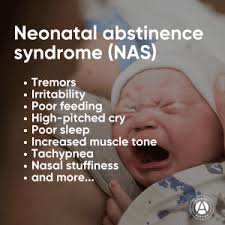 A drug withdrawal syndrome in newborns following birth.
A drug withdrawal syndrome in newborns following birth.
Every 18 minutes in the US, neonatal opioid withdrawal syndrome is diagnosed, in at least one newborn as a result of in utero opioid exposure.
The definition of opioid withdrawal in the neonate includes in utero exposure to opioids with or without exposure to other psychotropic substances and the presence of two of five of the most common clinical signs of opioid withdrawal in the neonate :excessive crying, fragmented sleep, tremors, increased muscle tone, and gastrointestinal dysfunction with possibly hyperphagia, poor feeding, feeding intolerance, or loose or watery stools.
A withdrawal syndrome of infants after birth caused by in utero exposure to drugs of dependence.
There are two types of NAS: prenatal and postnatal.
Prenatal NAS is caused by discontinuation of drugs taken by the pregnant mother, while postnatal NAS is caused by discontinuation of drugs directly to the infant.
The infant of a mother taking drugs may need to stay in the hospital for observation and monitoring for up to a week.
NAS may occur when a pregnant woman takes opioids such as heroin, codeine, oxycodone, methadone or buprenorphine.
Benzodiazepines, barbiturates, and certain antidepressants (SSRIs) can cause dependence in the infant while in the womb.
Symptoms of NAS often begin within one to three days after birth, but may take up to a week to appear.
Increasing use of opioids in pregnancy effects an estimated 5.6 per 1000 births.
Increase in rates.
This syndrome most commonly occurs in the context of antepartum opiate use, although other drugs have been implicated.
Can occur after illicit opioid use or as an expected outcome from opioid agonist treatment with methadone and buprenorphine.
Buprenorphineis now the number one agent used for opioid abuse in pregnancy.
Typically manifests in the first few days of life with hypertonia, autonomic instability, irritability, poor sucking reflex, impaired weight gain, and less commonly seizures.
Characterized by a varying degree of signs and symptoms including increased irritability, hypertonia, tremors, poor feeding, vomiting, watery diarrhea, seizures, and respiratory distress.
Sometimes causes the separation of mother and infant during a critical period of bonding.
Symptoms of withdrawal in NAS described in 60-80% of newborns exposed to heroine and methadone in utero.
Incidence increasing at a annual rate between 2000 2009 by threefold, consistent with increasing opiate use in the US.
The disorder is composed of signs and symptoms involving dysfunction of the central nervous system, gastrointestinal tract, and respiratory system because of in utero drug exposure or iatrogenic withdrawal after postnatal use of drugs for pain control and sedation.
Affects sleep, feeding and autonomic functions.
The severity of the withdrawal symptoms in the neonate is affected by the route of administration used by the mother, the metabolism and elimination of the drug from the mother’s system, and the length of time that the drug was taken, all impact the development of withdrawal symptoms in the newborn.
The newborn may experience irritability, or jitteriness, feeding problems, and diarrhea.
Symptoms vary depending on which substances were being taken by the mother.
Generally, infants going through withdrawal have a distinctive cry, described as being high-pitched, non-stop and shrill.
NAS infants withdrawing from drugs or alcohol may be hypertonic and have convulsions, increased Moro reflex, tremors, irritability, disturbed sleep patterns, fever, respiratory symptoms, tachypnea, apnea, nasal congestion, nasal flaring, blotchy skin, yawning, poor appetite, regurgitation, vomiting and diarrhea.
The sucking reflex can be incessant and uncoordinated.
Neonatal abstinence syndrome treatment can last from 1 week to 6 months.
Neonates withdrawing from methadone can have sleeping difficulties, seizures and a higher risk of dying from ineffective in suppression of seizures.
Phenobarbital is superior to diazepam for neonatal opiate withdrawal symptoms.
In the case of sedative-hypnotic neonatal withdrawal, phenobarbital is the treatment of choice.
Clinical factors, including maternal smoking, psychiatric medications, and breast-feeding can affect the incidence and severity of the syndrome.
Standard treatment for opiate addiction during pregnancy is methadone plus psychiatric care.
In case is left untreated there may be serious illness such as seizures and even death.
Opiate withdrawal often complicated by maternal exposure to psychiatric medications such as antidepressants and benzodiazepines, which have their own withdrawal syndromes.
60-80% of infants exposed in utero to opiates develop an abstinence syndrome, and require prolonged hospitalization.
May occur with both prescription and nonprescription opioid use by the mother, including with medication assisted therapy, which includes methadone and buprenorphine prescribed to pregnant women addicted to opioids.
NAS is used as a barometer to gauge subsequent effects of the opioid epidemic on families.
Length of hospital stay for newborns with NAS is 16 days.
Monitoring of the neonatal withdrawal syndrome requires reassessment every few hours to evaluate sleep, movements, feeding difficulties, as well as signs of opiate withdrawal such as yawning, tremors, and diarrhea.
Management includes oral methadone or morphine, gamma aminobutyric acid, benzodiazepines, or anti-adrenergic agents.
Buprenorphine is an effective alternative to methadone that can be prescribed in any outpatient setting, has a low risk of respiratory depression and reduces the severity of neonatal abstinence syndrome.
Infants who received buprenorphine, receive less morphine to treat the symptoms of neonatal abstinence syndrome, have a shorter duration of treatment for neonatal, abstinence syndrome, and a shorter hospital stay than infants exposed to methadone.
NAS is responsible for increasing portion of resources dedicated to critically ill neonates.
Higher rates of unemployment are associated with higher rates of NAS, especially in rural remote counties.
